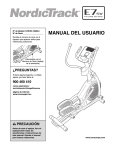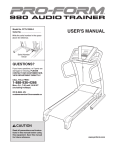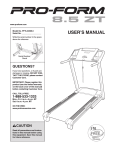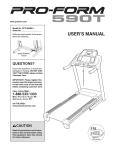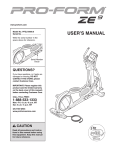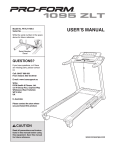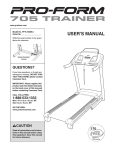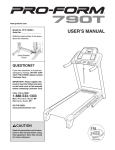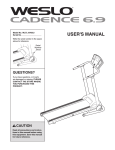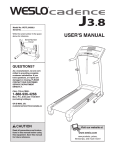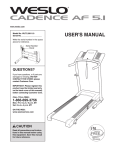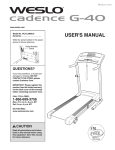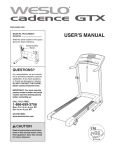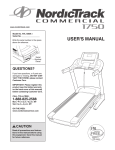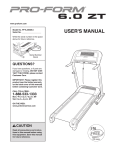Download Weslo Cadence 4.9 WLTL 14709.0 User's Manual
Transcript
Model No. WLTL14709.0 Serial No. Write the serial number in the space above for reference. Serial Number Decal QUESTIONS? If you have questions, or if parts are damaged or missing, PLEASE CONTACT THE STORE WHERE YOU PURCHASED THIS PRODUCT. CAUTION Read all precautions and instructions in this manual before using this equipment. Save this manual for future reference. USER'S MANUAL TABLE OF CONTENTS WARNING DECAL PLACEMENT . . . . . . . . . . . . . . . . . . . . . . . . . . . . . . . . . . . . . . . . . . . . . . . . . . . . . . . . . . . . . .2 IMPORTANT PRECAUTIONS . . . . . . . . . . . . . . . . . . . . . . . . . . . . . . . . . . . . . . . . . . . . . . . . . . . . . . . . . . . . . . . .3 BEFORE YOU BEGIN . . . . . . . . . . . . . . . . . . . . . . . . . . . . . . . . . . . . . . . . . . . . . . . . . . . . . . . . . . . . . . . . . . . . . .5 ASSEMBLY . . . . . . . . . . . . . . . . . . . . . . . . . . . . . . . . . . . . . . . . . . . . . . . . . . . . . . . . . . . . . . . . . . . . . . . . . . . . . . .6 OPERATION AND ADJUSTMENT . . . . . . . . . . . . . . . . . . . . . . . . . . . . . . . . . . . . . . . . . . . . . . . . . . . . . . . . . . . . .8 HOW TO FOLD AND MOVE THE TREADMILL . . . . . . . . . . . . . . . . . . . . . . . . . . . . . . . . . . . . . . . . . . . . . . . . . .13 TROUBLESHOOTING . . . . . . . . . . . . . . . . . . . . . . . . . . . . . . . . . . . . . . . . . . . . . . . . . . . . . . . . . . . . . . . . . . . . .14 EXERCISE GUIDELINES . . . . . . . . . . . . . . . . . . . . . . . . . . . . . . . . . . . . . . . . . . . . . . . . . . . . . . . . . . . . . . . . . . .16 PART LIST . . . . . . . . . . . . . . . . . . . . . . . . . . . . . . . . . . . . . . . . . . . . . . . . . . . . . . . . . . . . . . . . . . . . . . . . . . . . . .17 EXPLODED DRAWING . . . . . . . . . . . . . . . . . . . . . . . . . . . . . . . . . . . . . . . . . . . . . . . . . . . . . . . . . . . . . . . . . . . .18 ORDERING REPLACEMENT PARTS . . . . . . . . . . . . . . . . . . . . . . . . . . . . . . . . . . . . . . . . . . . . . . . . . .Back Cover WARNING DECAL PLACEMENT This drawing shows the location(s) of the warning decal(s). If a decal is missing or illegible, go to www.iconfitness.com and request a free replacement decal. Apply the decal in the location shown. Note: The decal(s) may not be shown at actual size. WESLO is a registered trademark of ICON IP, Inc. 2 IMPORTANT PRECAUTIONS WARNING: To reduce the risk of serious injury, read all important precautions and instructions in this manual and all warnings on your treadmill before using your treadmill. ICON assumes no responsibility for personal injury or property damage sustained by or through the use of this product. 1. Before beginning any exercise program, consult your physician. This is especially important for persons over age 35 or persons with pre-existing health problems. 11. Use only a single-outlet surge suppressor that meets all of the specifications described on page 8. To purchase a surge suppressor, please see your local electronics store. 2. It is the responsibility of the owner to ensure that all users of this treadmill are adequately informed of all warnings and precautions. 12. Failure to use a properly functioning surge suppressor could result in damage to the control system of the treadmill. If the control system is damaged, the walking belt may slow, accelerate, or stop unexpectedly, which may result in a fall and serious injury. 3. Use the treadmill only as described. 4. Place the treadmill on a level surface, with at least 8 ft. (2.4 m) of clearance behind it and 2 ft. (0.6 m) on each side. Do not place the treadmill on any surface that blocks air openings. To protect the floor or carpet from damage, place a mat under the treadmill. 13. Keep the power cord and the surge suppressor away from heated surfaces. 14. Never move the walking belt while the power is turned off. Do not operate the treadmill if the power cord or plug is damaged, or if the treadmill is not working properly. (See TROUBLESHOOTING on page 14 if the treadmill is not working properly.) 5. Keep the treadmill indoors, away from moisture and dust. Do not put the treadmill in a garage or covered patio, or near water. 6. Do not operate the treadmill where aerosol products are used or where oxygen is being administered. 15. Read, understand, and test the emergency stop procedure before using the treadmill (see HOW TO TURN ON THE POWER on page 10). 7. The treadmill should be used only by persons weighing 198 lbs. (90 kg) or less. 16. Never start the treadmill while you are standing on the walking belt. Always hold the handrails while using the treadmill. 8. Never allow more than one person on the treadmill at a time. 17. The treadmill is capable of high speeds. Adjust the speed in small increments to avoid sudden jumps in speed. 9. Wear appropriate exercise clothes when using the treadmill. Do not wear loose clothes that could become caught in the treadmill. Athletic support clothes are recommended for both men and women. Always wear athletic shoes. Never use the treadmill with bare feet, wearing only stockings, or in sandals. 18. The pulse sensor is not a medical device. Various factors, including the user's movement, may affect the accuracy of heart rate readings. The pulse sensor is intended only as an exercise aid in determining heart rate trends in general. 10. When connecting the power cord (see page 8), plug the power cord into a surge suppressor (not included) and plug the surge suppressor into a grounded circuit capable of carrying 15 or more amps. No other appliance should be on the same circuit. Do not use an extension cord. 19. Never leave the treadmill unattended while it is running. Always remove the key, unplug the power cord, and switch the on/off switch to the off position when the treadmill is not in use. (See the drawing on page 5 for the location of the switch.) 3 20. Do not attempt to raise, lower, or move the treadmill until it is properly assembled. (See ASSEMBLY on page 6, and HOW TO FOLD AND MOVE THE TREADMILL on page 13.) You must be able to safely lift 45 lbs. (20 kg) to raise, lower, or move the treadmill. treadmill, and before performing the maintenance and adjustment procedures described in this manual. Never remove the motor hood unless instructed to do so by an authorized service representative. Servicing other than the procedures in this manual should be performed by an authorized service representative only. 21. When folding or moving the treadmill, make sure that the storage latch is holding the frame securely in the storage position. 25. This treadmill is intended for in-home use only. Do not use this treadmill in a commercial, rental, or institutional setting. 22. Never insert any object into any opening on the treadmill. 26. Over exercising may result in serious injury or death. If you feel faint or if you experience pain while exercising, stop immediately and cool down. 23. Inspect and properly tighten all parts of the treadmill regularly. 24. DANGER: Always unplug the power cord immediately after use, before cleaning the SAVE THESE INSTRUCTIONS 4 BEFORE YOU BEGIN Thank you for selecting the WESLO® CADENCE 4.9 treadmill. The CADENCE 4.9 treadmill offers an impressive selection of features designed to make your workouts at home more enjoyable and effective. And when youʼre not exercising, the unique treadmill can be folded up, requiring less than half the floor space of other treadmills. ing this manual, please see the front cover of this manual. To help us assist you, note the product model number and serial number before contacting us. The model number and the location of the serial number decal are shown on the front cover of this manual. Before reading further, please familiarize yourself with the parts that are labeled in the drawing below. For your benefit, read this manual carefully before using the treadmill. If you have questions after read- Console Pulse Sensor Handrail Upright Key/Clip Latch Knob Walking Belt On/Off Switch Foot Rail Power Cord Wheel Idler Roller Adjustment Bolts 5 ASSEMBLY Assembly requires two persons. Set the treadmill in a cleared area and remove all packing materials. Do not dispose of the packing materials until assembly is completed. Note: The underside of the treadmill walking belt is coated with high-performance lubricant. During shipping, some lubricant may be transferred to the top of the walking belt or the shipping carton. This is normal and does not affect treadmill performance. If there is lubricant on top of the walking belt, simply wipe off the lubricant with a soft cloth and a mild, non-abrasive cleaner. Upright Knob (35) Base Knob (39) Handrail Knob (10) 1. Make sure that the power cord is unplugged. Console Knob (4) 1 Pull and hold the Latch Knob (12). With the help of a second person, raise the Left and Right Uprights (11, 14) to the vertical position. Release the Latch Knob. 12 14 11 2. Firmly tighten the two Base Knobs (39) into the Base (37) and the Uprights (11, 14). 2 Make sure that the Base Knobs (39) are fully tightened each time you use the treadmill. 14 11 37 6 39 39 3. Firmly tighten the two Upright Knobs (35) into the lower ends of the Uprights (11, 14). 3 Make sure that the Upright Knobs (35) are fully tightened each time you use the treadmill. 14 35 11 35 4. Pivot the Handrail (3) up as shown. Firmly tighten the two Handrail Knobs (10) into the upper ends of the Uprights (11, 14). 4 Make sure that the Handrail Knobs (10) are fully tightened each time you use the treadmill. 10 3 14 10 5. Pivot the Console (1) to the desired position, and tighten the two Console Knobs (4). 5 Make sure that the Console Knobs (4) are fully tightened each time you use the treadmill. 11 1 4 4 6. Make sure that all parts are properly tightened before you use the treadmill. If there are sheets of clear plastic on the treadmill decals, remove the plastic. To protect the floor or carpet, place a mat under the treadmill. Keep the included hex key in a secure place; the hex key is used to adjust the walking belt (see pages 14 and 15). 7 OPERATION AND ADJUSTMENT HOW TO PLUG IN THE POWER CORD This product is for use on a nominal 120-volt circuit, and has a grounding plug that looks like the plug illustrated in drawing 1 below. A temporary adapter that looks like the adapter illustrated in drawing 2 may be used to connect the surge suppressor to a 2-pole receptacle as shown in drawing 2 if a properly grounded outlet is not available. DANGER: Improper connection of the equipment-grounding conductor can result in an increased risk of electric shock. Check with a qualified electrician or serviceman if you are in doubt as to whether the product is properly grounded. Do not modify the plug provided with the product—if it will not fit the outlet, have a proper outlet installed by a qualified electrician. 1 Grounded Outlet Box Surge Suppressor Grounding Pin Your treadmill, like any other type of sophisticated electronic equipment, can be seriously damaged by sudden voltage changes in your homeʼs power. Voltage surges, spikes, and noise interference can result from weather conditions or from other appliances being turned on or off. To decrease the possibility of your treadmill being damaged, always use a surge suppressor with your treadmill (see drawing 1 at the right). To purchase a surge suppressor, please see your local electronics store. Grounding Pin Grounded Outlet 2 Use only a single-outlet surge suppressor that is UL 1449 listed as a transient voltage surge suppressor (TVSS). The surge suppressor must have a UL suppressed voltage rating of 400 volts or less and a minimum surge dissipation of 450 joules. The surge suppressor must be electrically rated for 120 volts AC and 15 amps. There must be a monitoring light on the surge suppressor to indicate whether it is functioning properly. Failure to use a properly functioning surge suppressor could result in damage to the control system of the treadmill. If the control system is damaged, the walking belt may slow, accelerate, or stop unexpectedly, which may result in a fall and serious injury. Grounding Plug Grounded Outlet Box Adapter Lug Metal Screw Surge Suppressor Grounding Plug The temporary adapter should be used only until a properly grounded outlet (drawing 1) can be installed by a qualified electrician. The green-colored rigid ear, lug, or the like extending from the adapter must be connected to a permanent ground such as a properly grounded outlet box cover. Whenever the adapter is used it must be held in place by a metal screw. Some 2-pole receptacle outlet box covers are not grounded. Contact a qualified electrician to determine if the outlet box cover is grounded before using an adapter. This product must be grounded. If it should malfunction or break down, grounding provides a path of least resistance for electric current to reduce the risk of electric shock. This product is equipped with a cord having an equipment-grounding conductor and a grounding plug. Plug the power cord into a surge suppressor, and plug the surge suppressor into an appropriate outlet that is properly installed and grounded in accordance with all local codes and ordinances. IMPORTANT: The treadmill is not compatible with GFCI-equipped outlets. 8 CONSOLE DIAGRAM Key Clip FEATURES OF THE CONSOLE To turn on the power, see page 10. To use the manual mode, see page 10. To use a preset workout, see page 12. The treadmill console offers an array of features designed to make your workouts more effective and enjoyable. When you use the manual mode, you can change the speed of the treadmill with the touch of a button. As you exercise, the console will display instant exercise feedback. You can even measure your heart rate using the handgrip pulse sensor. IMPORTANT: If there is a sheet of plastic on the console, remove the plastic. To prevent damage to the walking platform, wear clean athletic shoes while using the treadmill. The first time you use the treadmill, observe the alignment of the walking belt, and center the walking belt if necessary (see page 15). In addition, the console offers five preset workouts. Each workout automatically controls the speed of the treadmill as it guides you through an effective exercise session. 9 HOW TO TURN ON THE POWER IMPORTANT: If the treadmill has been exposed to cold temperatures, allow it to warm to room temperature before turning on the power. If you do not do this, you may damage the console displays or other electrical components. Plug in the power cord (see page 8). Next, locate the on/off switch on the treadmill frame near the power cord. Push the switch to the on position. On Next, stand on the foot rails of the treadmill. Find the clip attached to the key (see the drawing on page 9) and slide the clip onto the waistband of your clothes. Then, insert the key into the console. After a moment, the displays will light. IMPORTANT: In an emergency situation, the key can be pulled from the console, causing the walking belt to slow to a stop. Test the clip by carefully taking a few steps backward; if the key is not pulled from the console, adjust the position of the clip. HOW TO USE THE MANUAL MODE 1. Insert the key into the console. See HOW TO TURN ON THE POWER at the left. Press the Power button on the console or the Power button on the handrail. 2. Select the manual mode. When the key is inserted, the manual mode will be selected. If a preset workout has been selected, remove the key and then reinsert it. 3. Start the walking belt. To start the walking belt, press the Start button. The walking belt will begin to move at 0.7 Km/H. As you exercise, change the speed of the walking belt as desired by pressing the Speed increase and decrease buttons on the console or the Speed buttons on the handrail. Each time you press one of the buttons, the speed setting will change by 0.1 Km/H. Note: After you press a button, it may take a moment for the walking belt to reach the selected speed setting. To stop the walking belt, press the Stop button. To restart the walking belt, press the Start button. 10 4. Follow your progress with the display. To measure your heart rate, stand on the foot rails and hold the metal contacts on the handrail. Avoid moving your hands. When your pulse is detected, your heart rate will be shown. For the most accurate heart rate reading, continue to hold the contacts for about 15 seconds. As you exercise, the display can show the speed of the walking belt, the elapsed time, the distance that you have walked or run, and the approximate number of calories you have burned. The display will also show your heart rate when you use the handgrip pulse sensor (see step 5). Press the Mode button repeatedly until the display shows the information that you are most interested in viewing. 6. When you are finished exercising, remove the key from the console. Step onto the foot rails, press the Stop button, and press the Power button. Remove the key from the console and put it in a secure place. To reset the display, press the Reset button. 5. Measure your heart rate if desired. If there are sheets of plastic on the metal contacts, remove the plastic before using the handgrip pulse sensor. In addition, make sure that your hands are clean. When you are finished using the treadmill, switch the on/off switch to the off position and unplug the power cord. IMPORTANT: If you do not do this, the treadmillʼs electrical components may wear prematurely. Contacts 11 HOW TO USE A PRESET WORKOUT The workout will continue in this way until the last segment ends. The walking belt will then slow to a stop. 1. Insert the key into the console. If the speed setting is too high or too low at any time during the workout, you can manually override the setting by pressing the Speed buttons; however, when the next segment of the workout begins, the treadmill will automatically adjust to the speed setting for the next segment. See step 1 on page 10. 2. Select a preset workout. To select a preset workout, press the Prog button repeatedly until the desired workout appears in the display. Note: The name and profile of each workout is listed on the console. To stop the workout at any time, press the Stop button. To restart the workout, press the Start button. The walking belt will begin to move. When the next segment of the workout begins, the treadmill will automatically adjust to the speed setting for the next segment. Press the Speed increase and decrease buttons to adjust the duration of the workout. 3. Start the walking belt. Press the Start button to start the workout. A moment after you press the button, the treadmill will automatically adjust to the first speed setting of the workout. Hold the handrails and begin walking. Each workout is divided into segments. One speed setting is programmed for each segment. Note: The same speed setting may be programmed for consecutive segments. Tones will sound at the end of each segment. The treadmill will then automatically adjust to the speed setting for the next segment. 4. Follow your progress with the display. See step 4 on page 11. 5. Measure your heart rate if desired. See step 5 on page 11. 6. When you are finished exercising, remove the key from the console. See step 6 on page 11. 12 HOW TO FOLD AND MOVE THE TREADMILL HOW TO FOLD THE TREADMILL FOR STORAGE Before folding the treadmill, remove the key and unplug the power cord. CAUTION: You must be able to safely lift 45 lbs. (20 kg) to raise, lower, or move the treadmill. 1 1. Hold the metal frame firmly in the location shown by the arrow at the right. CAUTION: To decrease the possibility of injury, do not lift the frame by the plastic foot rails. Bend your legs and keep your back straight as you raise the frame. Raise the frame about halfway to the vertical position. 2. Pull the latch knob to the left and hold it. Raise the frame until the latch knob aligns with the hole in the latch plate, and release the latch knob. Make sure that the latch knob pin is fully inserted into the latch plate. To protect the floor or carpet from damage, place a mat under the treadmill. Keep the treadmill out of direct sunlight. Do not leave the treadmill in the storage position in temperatures above 85° F (30° C). Frame 2 Latch Knob Latch Plate HOW TO MOVE THE TREADMILL Before moving the treadmill, convert the treadmill to the storage position as described above. Make sure that the latch knob pin is fully inserted into the latch plate. 1. Hold an upright and place a foot against one of the wheels. 2. Tip the treadmill back until it rolls freely on the wheels. Carefully move the treadmill to the desired location. Never move the treadmill without tipping it back. To reduce the risk of injury, use extreme caution while moving the treadmill. Do not attempt to move the treadmill over an uneven surface. 3. Place one foot against a wheel, and carefully lower the treadmill until it is resting in the storage position. HOW TO LOWER THE TREADMILL FOR USE 1. See drawing 2. Hold the upper end of the treadmill with your right hand. Pull the latch knob to the left and hold it. Pivot the frame downward and release the latch knob. 2. See drawing 1. Hold the metal frame firmly with both hands and lower it to the floor. CAUTION: Do not grip only the plastic foot rails or drop the frame to the floor. Bend your legs and keep your back straight. 13 TROUBLESHOOTING Most treadmill problems can be solved by following the steps below. Find the symptom that applies, and follow the steps listed. If further assistance is needed, please see the front cover of this manual. PROBLEM: The power does not turn on SOLUTION: a. Make sure that the power cord is plugged into a surge suppressor, and that the surge suppressor is plugged into a properly grounded outlet (see page 8). Use only a single-outlet surge suppressor that meets all of the specifications described on page 8. IMPORTANT: The treadmill is not compatible with GFCI-equipped outlets. b. After the power cord has been plugged in, make sure that the key is inserted into the console. c. Check the on/off switch located on the treadmill frame near the power cord. If the switch protrudes as shown, the switch has tripped. To reset the switch, wait for five minutes and then press the switch back in. c Tripped On PROBLEM: The power turns off during use SOLUTION: a. Check the on/off switch (see the drawing above). If the switch has tripped, wait for five minutes and then press the switch back in. b. Make sure that the power cord is plugged in. If the power cord is plugged in, unplug it, wait for five minutes, and then plug it back in. c. Remove the key from the console. Reinsert the key into the console. d. If the treadmill still will not run, please see the front cover of this manual. PROBLEM: The walking belt slows when walked on SOLUTION: a. Use only a single-outlet surge suppressor that meets all of the specifications described on page 8. b. If the walking belt is overtightened, treadmill performance may decrease and the walking belt may become damaged. Remove the key and UNPLUG THE POWER CORD. Using the hex key, turn both idler roller bolts counterclockwise, 1/2 of a turn. When the walking belt is properly tightened, you should be able to lift each edge of the walking belt 2 to 3 in. (5 to 7 cm) off the walking platform. Be careful to keep the walking belt centered. Then, plug in the power cord, insert the key, and run the treadmill for a few minutes. Repeat until the walking belt is properly tightened. b 2–3 in. Idler Roller Bolts c. If the walking belt still slows when walked on, see the front cover of this manual. 14 PROBLEM: The walking belt is off-center or slips when walked on SOLUTION: a. If the walking belt is off-center, first remove the key and UNPLUG THE POWER CORD. If the walking belt has shifted to the left, use the hex key to turn the left idler roller bolt clockwise 1/2 of a turn and the right idler roller bolt counterclockwise 1/2 of a turn; if the walking belt has shifted to the right, turn the left idler roller bolt counterclockwise 1/2 of a turn and the right idler roller bolt clockwise 1/2 of a turn. Be careful not to overtighten the walking belt. Then, plug in the power cord, insert the key, and run the treadmill for a few minutes. Repeat until the walking belt is centered. b. If the walking belt slips when walked on, first remove the key and UNPLUG THE POWER CORD. Using the hex key, turn both idler roller bolts clockwise, 1/2 of a turn. When the walking belt is correctly tightened, you should be able to lift each edge of the walking belt 2 to 3 in. (5 to 7 cm) off the walking platform. Be careful to keep the walking belt centered. Then, plug in the power cord, insert the key, and carefully walk on the treadmill for a few minutes. Repeat until the walking belt is properly tightened. a b LUBRICATING THE WALKING BELT Periodically lubricate the walking belt with a silicone-based lubricant. IMPORTANT: Never use petroleum-based lubricants, which will damage the walking platform and the walking belt. To lubricate the walking belt, first remove the key from the console and unplug the power cord. Pull the left and right edges of the walking belt toward the back of the treadmill, until the seam of the walking belt is above the middle of the walking platform. Avoid pinching your fingers. Lift the right edge of the walking belt and spray lubricant underneath the walking belt for approximately four seconds. Make sure to spray lubricant near the center of the walking belt and near the front and back of the treadmill. Repeat this step on the left side of the treadmill. Wait for one minute before starting the treadmill. 15 Seam EXERCISE GUIDELINES WARNING: Before beginning this Burning Fat—To burn fat effectively, you must exercise at a low intensity level for a sustained period of time. During the first few minutes of exercise, your body uses carbohydrate calories for energy. Only after the first few minutes of exercise does your body begin to use stored fat calories for energy. If your goal is to burn fat, adjust the intensity of your exercise until your heart rate is near the lowest number in your training zone. For maximum fat burning, exercise with your heart rate near the middle number in your training zone. or any exercise program, consult your physician. This is especially important for persons over age 35 or persons with pre-existing health problems. The pulse sensor is not a medical device. Various factors may affect the accuracy of heart rate readings. The pulse sensor is intended only as an exercise aid in determining heart rate trends in general. Aerobic Exercise—If your goal is to strengthen your cardiovascular system, you must perform aerobic exercise, which is activity that requires large amounts of oxygen for prolonged periods of time. For aerobic exercise, adjust the intensity of your exercise until your heart rate is near the highest number in your training zone. These guidelines will help you to plan your exercise program. For detailed exercise information, obtain a reputable book or consult your physician. Remember, proper nutrition and adequate rest are essential for successful results. WORKOUT GUIDELINES EXERCISE INTENSITY Warming Up—Start with 5 to 10 minutes of stretching and light exercise. A warm-up increases your body temperature, heart rate, and circulation in preparation for exercise. Whether your goal is to burn fat or to strengthen your cardiovascular system, exercising at the proper intensity is the key to achieving results. You can use your heart rate as a guide to find the proper intensity level. The chart below shows recommended heart rates for fat burning and aerobic exercise. Training Zone Exercise—Exercise for 20 to 30 minutes with your heart rate in your training zone. (During the first few weeks of your exercise program, do not keep your heart rate in your training zone for longer than 20 minutes.) Breathe regularly and deeply as you exercise–never hold your breath. Cooling Down—Finish with 5 to 10 minutes of stretching. Stretching increases the flexibility of your muscles and helps to prevent post-exercise problems. EXERCISE FREQUENCY To find the proper intensity level, find your age at the bottom of the chart (ages are rounded off to the nearest ten years). The three numbers listed above your age define your “training zone.” The lowest number is the heart rate for fat burning, the middle number is the heart rate for maximum fat burning, and the highest number is the heart rate for aerobic exercise. To maintain or improve your condition, complete three workouts each week, with at least one day of rest between workouts. After a few months of regular exercise, you may complete up to five workouts each week, if desired. Remember, the key to success is to make exercise a regular and enjoyable part of your everyday life. 16 PART LIST—Model No. WLTL14709.0 To locate the parts listed below, see the EXPLODED DRAWING near the end of this manual. Key No. Qty. 1 2 3 4 5 6 7 8 9 10 11 12 13 14 15 16 17 18 19 20 21 22 23 24 25 1 2 1 2 1 1 2 2 1 2 1 1 1 1 1 1 1 1 1 1 1 1 1 1 1 Description Key No. Qty. Console Long Foam Grip Handrail Console Knob Pulse Sensor/Speed Control Left Handrail Bracket Handrail Bracket Sleeve Handrail Cap Left Upright Cap Handrail Knob Left Upright Latch Knob Key/Clip Right Upright Right Upright Cap Motor Hood Belly Pan Walking Belt Left Foot Rail Walking Platform Motor Belt Motor Bracket Motor Drive Roller/Pulley Idler Roller 26 27 28 29 30 31 32 33 34 35 36 37 38 39 40 41 42 43 44 45 46 47 48 * * 1 1 2 1 1 1 1 1 1 2 1 1 2 2 2 1 1 1 1 1 1 1 1 – – R0110A Description Frame Crossbar Frame Leg Cap Left Frame Cap Controller Power Cord On/Off Switch Circuit Breaker Left Upright Cover Upright Knob Latch Plate Base Wheel Base Knob Short Foam Grip Pulse Sensor/Power Switch Right Handrail Bracket Right Foot Rail Right Frame Cap Controller Bracket Right Upright Cover Warning Decal Console Warning Decal Hex Key Userʼs Manual Note: Specifications are subject to change without notice. For information about ordering replacement parts, see the back cover of this manual. *These parts are not illustrated. 17 EXPLODED DRAWING A—Model No. WLTL14709.0 16 R0110A 43 19 24 22 20 21 23 30 45 31 33 32 18 47 27 26 25 36 37 44 39 28 39 38 17 28 38 18 29 EXPLODED DRAWING B—Model No. WLTL14709.0 1 2 48 3 13 4 2 R0110A 5 4 7 41 7 6 40 9 10 42 40 15 8 8 10 14 11 12 35 46 35 34 19 ORDERING REPLACEMENT PARTS To order replacement parts, please see the front cover of this manual. To help us assist you, be prepared to provide the following information when contacting us: • the model number and serial number of the product (see the front cover of this manual) • the name of the product (see the front cover of this manual) • the key number and description of the replacement part(s) (see the PART LIST and the EXPLODED DRAWING near the end of this manual) Part No. 295130 R0110A Printed in China © 2010 ICON IP, Inc.




















